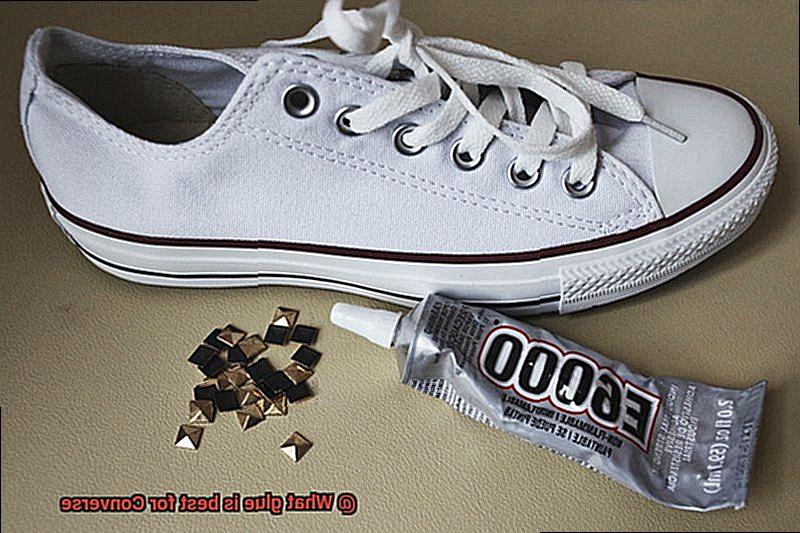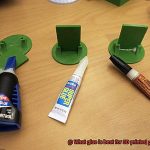Are your trusty Converse sneakers starting to show their age?
Maybe the soles are peeling away or the canvas is fraying at the seams. Don’t panic.
There’s a simple fix that can bring your Chucks back from the brink – glue. But with so many options out there, how do you know which one is best?
That’s where I come in. In this blog post, we’re going to explore all things glue and Converse.
We’ll dive into the pros and cons of different types of glue, from all-purpose wonders to specialized shoe adhesives. We’ll consider important factors like durability, flexibility, and ease of application to help you make an informed choice.
So buckle up, my fellow sneaker enthusiasts, because we’re about to embark on a journey to find the perfect glue for your beloved Converse kicks.
What Materials are Converse Shoes Made Of?
Contents
- 1 What Materials are Converse Shoes Made Of?
- 2 What Kind of Glue is Best for Converse Shoes?
- 3 Advantages of E6000 Adhesive
- 4 Advantages of Shoe Goo
- 5 Specialized Glues for Rubber Soles and Toe Caps
- 6 Factors to Consider When Choosing a Glue
- 7 Compatability with Other Types of Footwear or Materials
- 8 Proper Application and Curing Time
- 9 Conclusion
Converse shoes have become a timeless classic, beloved for their iconic design and durability. But have you ever wondered what materials make up these popular sneakers? In this comprehensive guide, we will explore the materials used in the construction of Converse shoes, including the upper, outsole, lining, laces, and even the best glue for repairs.
The Upper:
The upper part of Converse shoes is typically made from either canvas or leather. Canvas, a lightweight and breathable fabric, is known for its strength and durability. It allows air circulation, keeping your feet cool and comfortable. On the other hand, leather offers a more premium and sophisticated look. Highly durable, it molds to your foot over time for a customized fit.
The Outsole:
Converse shoes feature a rubber outsole that provides excellent traction and durability. This textured rubber sole ensures comfortable walking on different surfaces and contributes to the distinctive Converse style.
The Lining:
Inside the shoe, you’ll find a comfortable lining made from materials like cotton or synthetic fabrics. These linings wick away moisture, keeping your feet dry and preventing odors. Some Converse models also include additional padding or cushioning for enhanced comfort.
The Laces:
Converse shoes typically use flat cotton or polyester laces. Sturdy and easy to tie, these laces ensure a secure fit. With various color options available, you can customize and personalize your Converse shoes to suit your style.
What Glue is Best for Converse Shoe Repairs?
- E6000: Known for its industrial-strength formula, E6000 is a versatile adhesive suitable for bonding various materials commonly found in Converse shoes, including fabric, rubber, and plastic.
- Shoe Goo: Specifically designed for shoe repairs, Shoe Goo offers excellent adhesion to materials like rubber and canvas. It forms a flexible bond that can withstand constant movement and stress.
- Specialized Glues: There are also specialized glues available for bonding rubber soles or repairing specific parts of the shoe, such as the toe cap or sole. These glues provide extra strength and flexibility in those areas.
What Kind of Glue is Best for Converse Shoes?
If you’re a fan of the timeless style and comfort of Converse shoes, you know that wear and tear can sometimes take its toll on your beloved pair. But fear not, because we’re diving into the world of glue to find the best options for repairing your Converse shoes.
When it comes to choosing the right glue for Converse shoes, it’s essential to consider the materials used in their construction. Converse shoes are primarily made of canvas or rubber, so you’ll want a glue specifically designed to bond these materials effectively.
One popular choice among sneakerheads is Barge All-Purpose Cement. Known for its strong bond and durability, this adhesive is perfect for reattaching loose soles or detached parts of your Converse shoes. It’s also resistant to water, heat, and weathering, ensuring that your repairs will stand the test of time.
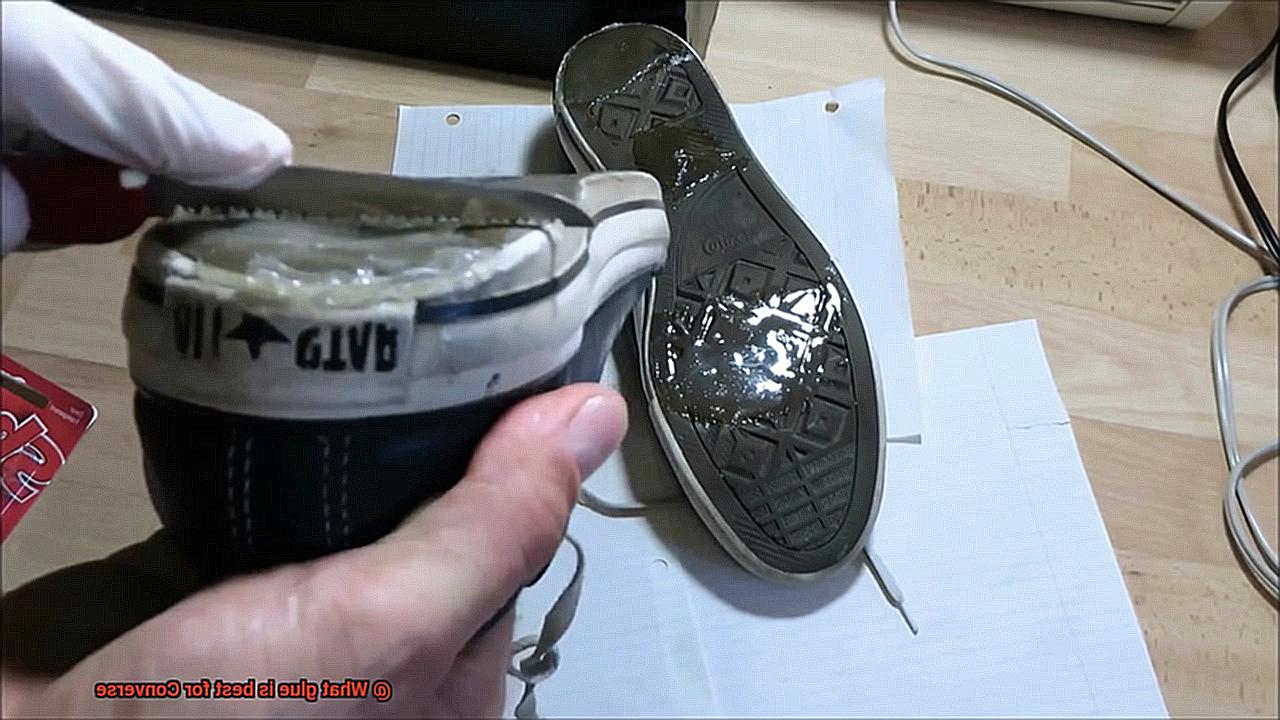
If you’re looking for a versatile option that can bond a wide range of materials, E6000 Craft Adhesive is worth considering. This glue offers a strong and flexible bond, making it ideal for fixing detached soles or repairing small tears in the canvas upper. It’s a go-to choice for many crafters and DIY enthusiasts.
Shoe Goo is another fan favorite when it comes to shoe repairs. Specially formulated for bonding various materials, including canvas and rubber, this adhesive dries clear and remains flexible once cured. Your repaired Converse shoes will retain their original appearance and flexibility.
For quick fixes or smaller repairs, super glues like Krazy Glue or Loctite Super Glue Gel can come to the rescue. These adhesives provide a fast bonding solution and work well for fixing small tears in the canvas or reattaching detached parts.
Remember, proper surface preparation is crucial for achieving a strong bond. Clean the surfaces you’re gluing thoroughly, removing any dirt, oil, or debris. Apply the glue evenly and follow the manufacturer’s instructions for drying and curing times.
It’s important to note that the best glue for your Converse shoes will depend on the specific repair or application. Consider factors like material type, required strength, flexibility, and any specific features like water or heat resistance. Always test the glue on a small, inconspicuous area before applying it to the entire repair area.
Lastly, don’t forget that proper maintenance and care of your Converse shoes can help prevent the need for extensive repairs. Keep them clean and protected, avoid excessive strain or wear, and address minor issues promptly to extend the lifespan of your favorite kicks.
Advantages of E6000 Adhesive
E6000 adhesive is a game-changer when it comes to repairing and customizing your beloved Converse shoes. This adhesive offers a multitude of advantages that make it the ultimate glue for all your shoe needs.
First and foremost, E6000 adhesive is known for its strong and durable bond. It has an exceptional grip and the ability to bond various materials together, including fabric, rubber, leather, and plastic. Once applied properly, it creates a long-lasting bond that can withstand the wear and tear that Converse shoes typically go through. No more worrying about your shoes falling apart.
But that’s not all – E6000 adhesive is incredibly versatile. It can be used on a wide range of surfaces, making it suitable for various repair and customization projects. Whether you need to fix a loose sole or attach some funky embellishments to your shoes, E6000 adhesive can handle it all.
Flexibility is another advantage of E6000 adhesive. Just like Converse shoes flex and bend with movement, this adhesive offers that same flexibility once it cures. This means that even with constant bending and flexing, the bond remains intact. You can wear your Converse shoes with confidence, knowing that they will stay in one piece.
And here’s the icing on the cake – E6000 adhesive is waterproof and weatherproof. No more worrying about water damage or your shoes falling apart in the rain or snow. This adhesive forms a moisture-resistant barrier when cured, keeping your shoes safe and secure in any weather condition.
Applying E6000 adhesive is a breeze too. It comes in a tube with a precision applicator tip, allowing for precise and controlled application. Plus, its thick consistency prevents it from running or dripping during application. Whether you’re doing a small touch-up or tackling a larger repair project, E6000 adhesive has got your back.
Another advantage of E6000 adhesive is its chemical resistance. It is resistant to various chemicals, making it perfect for Converse shoes that may come into contact with cleaning agents or gasoline. You don’t have to worry about the bond being affected – this adhesive has got you covered.
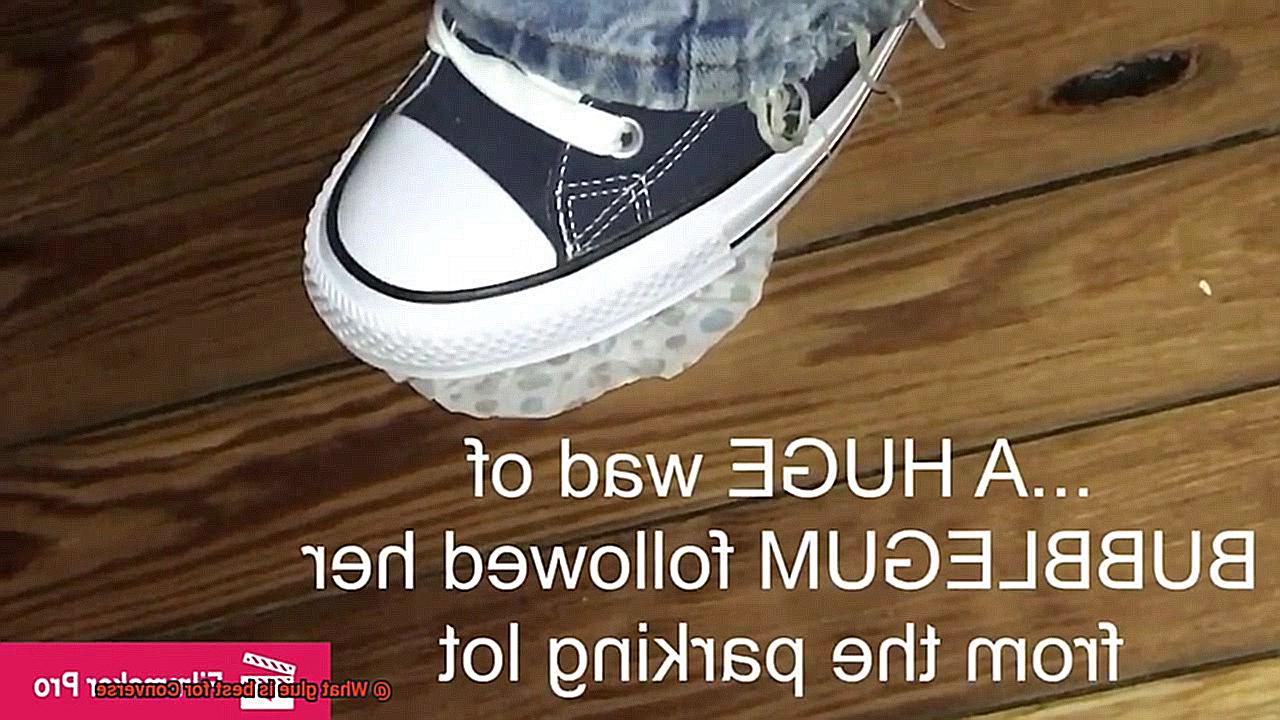
And let’s not forget about its professional-grade strength. E6000 adhesive is widely used by professionals in industries like footwear, jewelry making, and crafts. So you know you’re getting a top-notch product that will securely repair or customize your Converse shoes.
Advantages of Shoe Goo
I have the perfect solution for you – Shoe Goo. This remarkable adhesive acts as a magic wand for your shoes, reviving them and making them better than ever before.
The advantages of Shoe Goo are truly remarkable. Let’s delve into its extraordinary benefits, starting with its unrivaled durability. Once you apply Shoe Goo to your Converse shoes, it forms an unbreakable bond that can withstand the most rigorous activities. Say goodbye to worries about your soles coming apart or your shoes falling to pieces – Shoe Goo has got you covered, literally.
But wait, there’s more. Shoe Goo’s versatility is truly astonishing. It works wonders on a multitude of materials, from rubber to leather to canvas. Whether you need to repair a torn upper, mend stitching, or fix the sole, Shoe Goo rises to the occasion with unmatched efficacy.
Not only does Shoe Goo mend your shoes, but it also provides a protective shield. Its unique coating acts as an impervious barrier against moisture and other potential damage. Even if you accidentally step in a puddle or get caught in a downpour, the repaired section will remain safe and sound.
And let’s not forget about how user-friendly Shoe Goo is. With its convenient applicator tip, applying it directly to the affected area becomes a breeze. Moreover, it dries clear, leaving no unsightly residue on your precious shoes once it sets.
Now, I know what you’re thinking – how long do I have to wait before I can show off my repaired kicks once more? Fear not, my impatient friends, for Shoe Goo boasts a relatively quick drying time of a mere 24 hours. That means you’ll be back on your feet in no time, flaunting your restored pair of Chucks.
Last but certainly not least, let’s discuss the price tag. Shoe Goo is an affordable alternative for repairing your Converse shoes. Why splurge on new shoes or shell out a fortune for professional repairs when you can restore them yourself with this dependable adhesive?
Specialized Glues for Rubber Soles and Toe Caps
I’m here to introduce you to the world of specialized glues that will have your Converse shoes looking good as new. Let’s dive into the realm of these magical adhesives specifically designed for rubber soles and toe caps.
First up, we have the mighty Shoe Goo. This adhesive is a favorite among shoe repair professionals and DIY enthusiasts alike. With its exceptional bonding strength and flexibility, it’s perfect for those rubber soles and toe caps that need some extra love. Shoe Goo is designed to bond with various types of rubber, including the rubber used in Converse shoes. Plus, it can withstand extreme conditions like heat, cold, moisture, and even some chemicals. Talk about a strong bond.
Next on the list is Barge All-Purpose Cement. This adhesive is known for its bonding strength and durability. It forms a flexible yet robust bond that can handle the daily grind of wearing your Converse shoes. Like Shoe Goo, Barge All-Purpose Cement is specifically designed for rubber materials and offers excellent adhesion to various types of rubber.
But wait, there’s more. If you’re looking for alternatives, you can also consider E6000 Craft Adhesive, Amazing GOOP Automotive Adhesive, or Aleene’s Original Tacky Glue. These glues are also suitable for attaching rubber soles and toe caps on Converse shoes.
Now, before you start gluing away, there are a few best practices to keep in mind. Firstly, make sure you clean the surfaces thoroughly before applying the glue. Get rid of any dirt, dust, or old adhesive residue to ensure maximum adhesion. Follow the instructions provided by the manufacturer carefully and allow sufficient drying and curing time for optimal bond strength.
While these specialized glues work wonders, it’s essential to note that they’re not magic potions. Proper surface preparation and application are key to achieving a long-lasting bond. So take your time, follow the instructions, and before you know it, your Converse shoes will be back on your feet, ready for another adventure.
Factors to Consider When Choosing a Glue
Choosing the right glue for your Converse shoes is no small task. It requires careful consideration of several factors to ensure you make the best decision for your beloved sneakers. So, before you rush off to the store or click that “buy now” button online, take a moment to educate yourself on what to look for.
First and foremost, you need to consider material compatibility. Converse shoes are typically made of canvas or leather, so it’s crucial to choose a glue that works well with these materials. Using the wrong adhesive could lead to poor adhesion or even damage to your precious sneakers.

Strength and flexibility are also key considerations. Your Converse shoes go through a lot – walking, running, maybe even some skateboarding adventures. You need a glue that can withstand all that movement and stress without compromising the bond. Look for glues that explicitly mention their ability to handle flexing and bending.
Since Converse shoes often see the outdoors, it’s important to choose a glue with waterproof properties or at least water resistance. You don’t want your glue breaking down when exposed to rain or snow. This will help prolong the life of your shoes and keep them looking fresh.
Consider the drying time of the glue as well. Some adhesives dry quickly, allowing you to use your shoes sooner, while others may require longer curing times. Depending on your needs and patience level, choose a glue that suits your preference in terms of drying time.
Ease of use is another factor to consider. Look for glues that come with applicators or nozzles for easy and precise application. And if you make a mistake or need to reapply the glue, check if it’s easy to clean up or remove.
Finally, think about longevity and durability. You want a glue that will stand the test of time and keep your Converse shoes intact for as long as possible. Read customer reviews or ask fellow sneaker enthusiasts for recommendations to gain insights into the durability of different glue brands.
Compatability with Other Types of Footwear or Materials
Converse shoes are iconic and beloved by many, but over time, they may require repairs to extend their lifespan. Glue compatibility plays a crucial role in successfully repairing Converse shoes. Different types of footwear and materials require specific glues for optimal adhesion without causing damage or discoloration. In this guide, we will explore why glue compatibility is essential and provide a detailed explanation of how different types of footwear and materials require different glues for successful repairs.
Understanding the Materials:
To understand glue compatibility, it is crucial to familiarize yourself with the materials used in Converse shoes. Most Converse sneakers feature canvas uppers, rubber soles, and occasionally leather or synthetic accents. Each material requires a specific type of glue for a durable and effective bond.
Canvas Bonding:
Canvas is the star material in most Converse shoes due to its durability and breathability. Repairing canvas uppers requires fabric glues or contact adhesives specifically formulated for bonding fabrics. These glues offer flexibility and durability to withstand daily wear and tear.
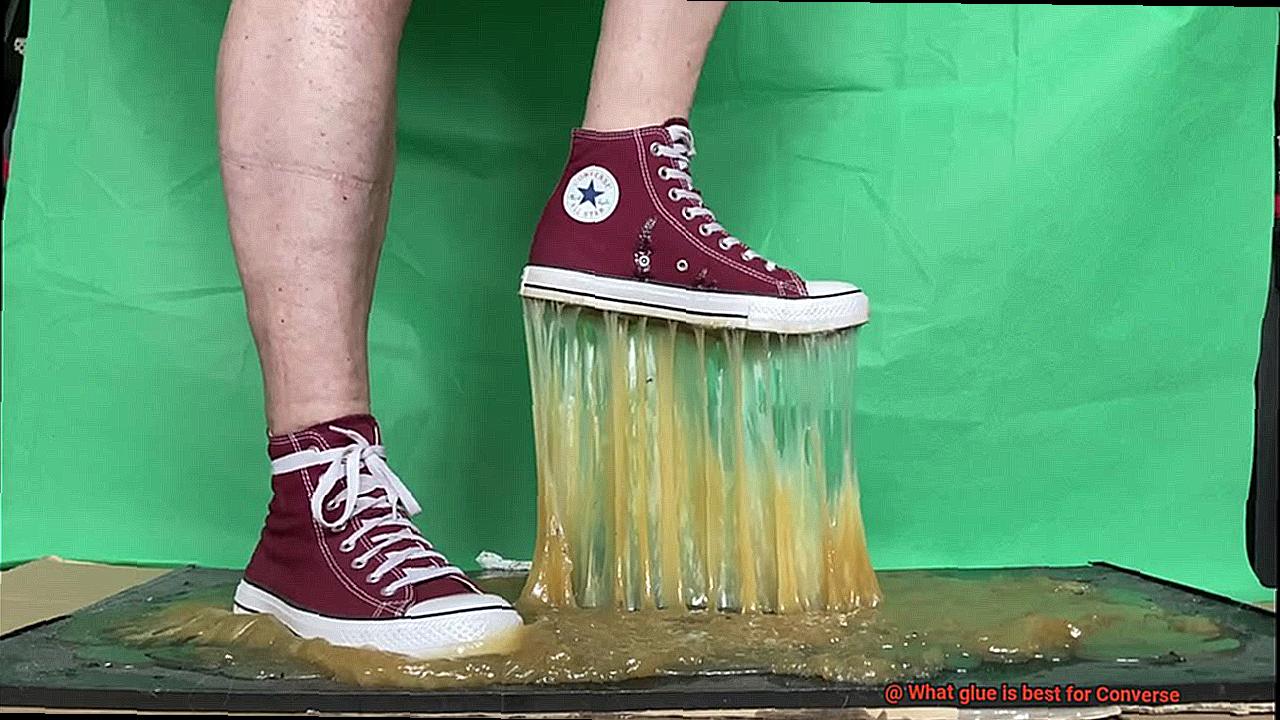
Leather and Synthetic Materials:
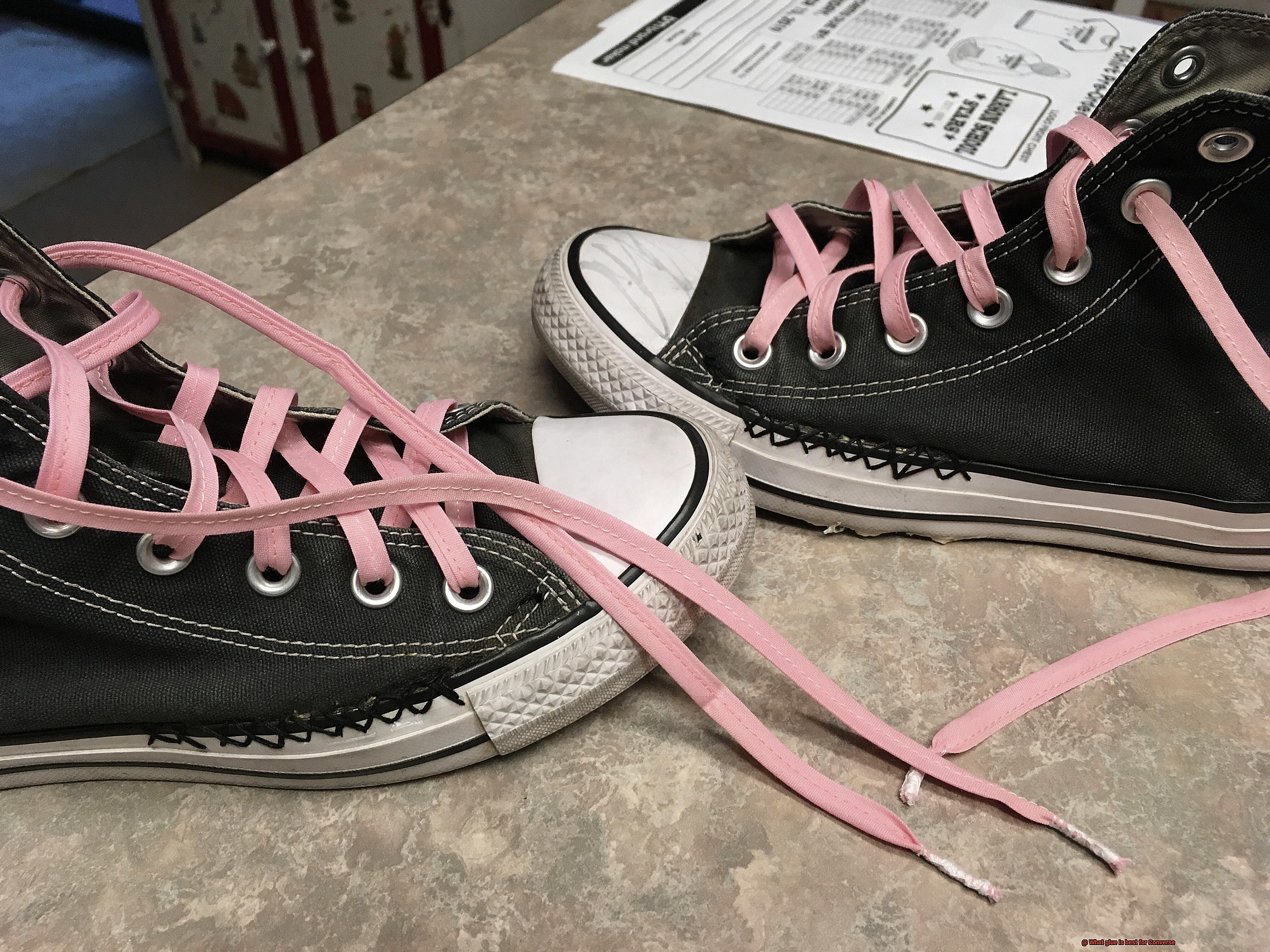
Some Converse shoes incorporate leather or synthetic materials into their design. When dealing with leather, it is crucial to use a leather-specific adhesive that bonds effectively without causing damage or discoloration. For synthetic materials, choose an adhesive compatible with bonding these specific materials.
Rubber Soles:
Many Converse shoes have rubber soles, making it essential to choose a glue compatible with rubber bonding. Rubber-compatible adhesives are specially formulated to create a strong bond that can withstand constant bending and flexing during wear.
Recommended Glues:
Two popular options for Converse shoe repairs are E6000 and Shoe Goo. E6000 is known for its industrial-strength formula and versatility in bonding various surfaces, including fabric, rubber, and plastic. Shoe Goo, specifically designed for shoe repairs, provides excellent adhesion to materials like rubber and canvas.
Application and Drying Time:
Consider the ease of application and drying time when choosing a glue. Some glues require longer drying times or multiple applications, which may be inconvenient for quick repairs. Opt for a glue that offers fast drying time and easy application for a hassle-free repair process.
Proper Application and Curing Time
Proper application and curing time are vital when it comes to gluing your beloved Converse shoes. As an expert in the art of adhesive, I’m here to share my knowledge on how to achieve a powerful and enduring bond for your favorite kicks.
The first step in proper application is to ensure that the surfaces you plan to glue are squeaky clean. Give them a thorough scrub with a mild detergent or soap and water to eliminate any lurking dirt, oil, or debris. This crucial step sets the stage for a strong bond by ensuring that the glue adheres properly.
Once your surfaces are clean and dry, it’s time to apply the glue. Take care not to go overboard with the adhesive – a thin layer is all you need. Use a brush or applicator to spread the glue evenly on both surfaces. Applying too much glue can lead to messy results and hinder proper bonding, so use a steady hand and exercise restraint.
Now that you’ve applied the glue, it’s time to bring those surfaces together. Make sure they align perfectly and press them firmly for a few minutes. This act of applying pressure helps the glue bond effectively, creating a connection that will withstand the test of time. If necessary, enlist the help of clamps or tape to hold everything in place while the glue dries.
Ah, curing time – the moment of truth. Different glues have different curing times, so it’s crucial to consult the instructions provided by the manufacturer. In general, most glues require at least 24 hours of curing time for maximum strength. During this period, it’s important to avoid excessive movement or stress on the glued area. Allow your shoes to rest undisturbed as they undergo their transformation from separate parts to a united whole.
Remember, environmental factors can influence curing time as well. Temperature and humidity levels play a role in how quickly the glue sets and hardens. To achieve optimal results, follow the manufacturer’s recommendations regarding temperature and humidity conditions.
Once the curing time has elapsed, it’s time to put your bond to the test. Gently pull on the glued surfaces – if they hold firmly without any signs of separation, then congratulations. Your Converse shoes are ready to strut their stuff.
To maintain the integrity of the glued bond over time, regular maintenance and inspections are key. Should you need to make any repairs or touch-ups, be sure to remove any excess glue with a solvent or adhesive remover before reapplying. This ensures a clean and effective bond that will keep your kicks looking fresh.
JAaIZa3pZMc” >
Conclusion
When it comes to finding the best glue for Converse shoes, there are a few options that stand out. One popular choice is Shoe Goo, a strong adhesive specifically designed for footwear repairs. Its thick consistency and flexible nature make it perfect for bonding the various materials used in Converse sneakers.
Another reliable option is Barge All-Purpose Cement. This industrial-strength adhesive creates a long-lasting bond that can withstand the wear and tear of everyday use. It’s particularly effective on rubber soles and canvas uppers, which are common features of Converse shoes.
For those looking for a quick fix, E6000 Craft Adhesive is worth considering. This versatile glue dries clear and provides a strong hold on different surfaces, including fabric and rubber. It’s easy to apply and sets quickly, making it ideal for minor repairs on your beloved Converse kicks.
No matter which glue you choose, it’s important to follow the manufacturer’s instructions carefully and allow sufficient drying time before wearing your shoes again. Remember to clean the surfaces thoroughly before applying the adhesive to ensure optimal adhesion.
In conclusion, when it comes to gluing your Converse shoes back together, Shoe Goo, Barge All-Purpose Cement, and E6000 Craft Adhesive are all excellent options. Each offers its own unique benefits in terms of strength, flexibility, and ease of use. So go ahead and give your favorite Chucks a new lease on life with the right glue.

